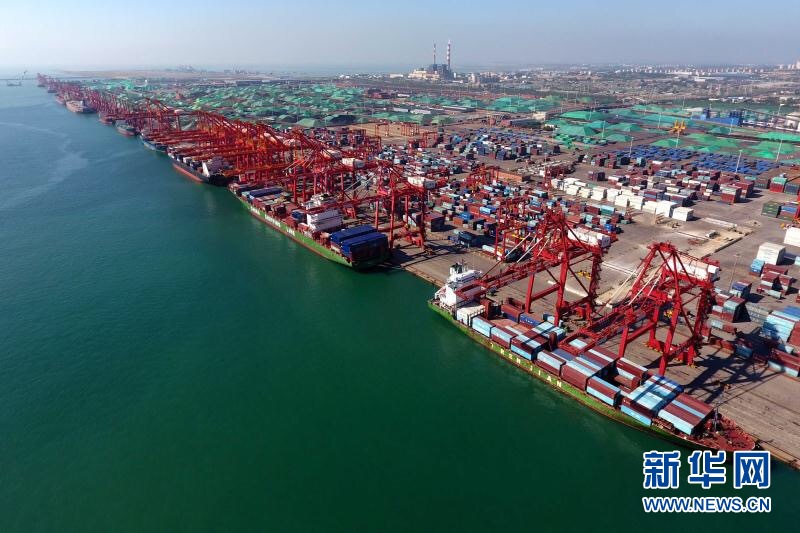


(Photo/Xinhua)
Over the past 70 years since the founding of the People’s Republic of China, China has not only created a miracle of economic development unprecedented in human history but grown into the most robust engine of global economic growth.
Through efforts to jointly explore new ways of development, share opportunities for development, and tackle challenges with various countries in the world, China has become a good stabilizer and driving force for the world.
As the world’s largest developing country, China has helped expand developing countries’ approaches to modernization, and provided brand new choices for those countries which hope to accelerate their development while maintaining independence, said Feng Weijiang, researcher at Institute of World Economics and Politics of Chinese Academy of Social Sciences (CASS).
China is the biggest contributor to world economic growth, said Singaporean Chinese-language newspaper Lianhe Zaobao, citing the white paper titled “China and the World in the New Era” issued by the State Council Information Office of China recently.
From 2013 to 2018, China contributed more than 28 percent to total world economic growth on average, according to the white paper, indicating that estimates show that without China, the average annual growth rate of the world economy from 2013 to 2016 would have slowed by 0.6 percentage point and the intensity of fluctuation would have increased by 5.2 percent.
Between 2000 and 2017, the aggregate index of the world’s exposure to China’s economy rose from 0.4 to 1.2, with China accounting for 35 percent of global manufacturing output, suggested a report released by the McKinsey Global Institute (MGI).
In recent years, China’s Belt and Road Initiative (BRI) has become a new engine for global economic growth. According to a research report released by the World Bank, BRI will help 7.6 million people of relevant countries get rid of extreme poverty and help bring 3200 million people out of moderate poverty.
The initiative will bring about a 2.8 to 9.7 percent increase in the trade of participating countries, a 1.7 to 6.2 percent increase in global trade, and a 0.7 to 2.9 percent growth in global income, said the report.
China is both the world’s factory and a global market, said a member of the Kyrgyz parliament, explaining that with a population of around 1.4 billion and 400 million in the middle-income group, China is the consumer market representing the greatest potential and business opportunities in the world.
China’s development is an opportunity for the world, said Enrique Dussel, head of China-Mexico Studies Center at the National Autonomous University of Mexico, adding that China is transforming its economic growth mode from high-speed development to high-quality development, and that China’s solutions and contributions to the world have an good demonstrative effect to be of reference in all considerations pertaning to development of world economy.
In 2018, as global FDI continued to slide and fell by 13 percent from the previous year, China secured its position as the world’s second largest destination of FDI, as indicated by the “World Investment Report 2019” of the United Nations Conference on Trade and Development (UNCTAD).
In the first half of 2019, China saw its actual use of foreign investment grow by 7.2 percent when compared to that of a year ago, which has brought to world economy analysts a sense of confidence and hope.
While promoting social progress, economic prosperity, and improving people’s well-being in its own country, China continually provides the world such development ideas as win-win cooperation, extensive consultation, joint contribution, and shared benefits, bringing new choices to the development of other countries, pointed out a scholar of the center of investigation of international politics of Cuba.
With a more stable economy, higher quality of economic growth, and good prospects for growth, China has played a positive role in the long-term development of world economy, said Jiang Ruiping, former vice-president of China Foreign Affairs University.
 Fire brigade in Shanghai holds group wedding
Fire brigade in Shanghai holds group wedding Tourists enjoy ice sculptures in Datan Town, north China
Tourists enjoy ice sculptures in Datan Town, north China Sunset scenery of Dayan Pagoda in Xi'an
Sunset scenery of Dayan Pagoda in Xi'an Tourists have fun at scenic spot in Nanlong Town, NW China
Tourists have fun at scenic spot in Nanlong Town, NW China Harbin attracts tourists by making best use of ice in winter
Harbin attracts tourists by making best use of ice in winter In pics: FIS Alpine Ski Women's World Cup Slalom
In pics: FIS Alpine Ski Women's World Cup Slalom Black-necked cranes rest at reservoir in Lhunzhub County, Lhasa
Black-necked cranes rest at reservoir in Lhunzhub County, Lhasa China's FAST telescope will be available to foreign scientists in April
China's FAST telescope will be available to foreign scientists in April "She power" plays indispensable role in poverty alleviation
"She power" plays indispensable role in poverty alleviation Top 10 world news events of People's Daily in 2020
Top 10 world news events of People's Daily in 2020 Top 10 China news events of People's Daily in 2020
Top 10 China news events of People's Daily in 2020 Top 10 media buzzwords of 2020
Top 10 media buzzwords of 2020 Year-ender:10 major tourism stories of 2020
Year-ender:10 major tourism stories of 2020 No interference in Venezuelan issues
No interference in Venezuelan issues
 Biz prepares for trade spat
Biz prepares for trade spat
 Broadcasting Continent
Broadcasting Continent Australia wins Chinese CEOs as US loses
Australia wins Chinese CEOs as US loses